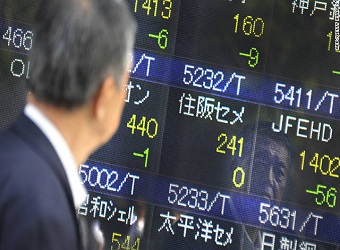Asian shares hit the skids and the dollar stood tall on Tuesday as a batch of upbeat U.S. economic data confirmed the Federal Reserve’s inexorable tilt towards reducing its stimulus soon, while the yen sank on talk of further central bank easing.
With the prospect of more cheap BOJ funds in the offing and a weakened currency firing up the export sector, Japanese stocks raced towards a six-year high.
In Europe, financial bookmakers are tipping a more subdued start with major indexes.FTSE .GDAXI .FCHI seen opening as much as 0.3 percent lower.
The U.S. Institute for Supply Management’s index of national factory activity rose in November to its best showing since April 2011, while the pace of hiring also accelerated.
“If the employment and inflation data also beat expectations, questions will get louder about when the Fed will move, and this will see risk currencies in the firing line,” Evan Lucas, market strategist at financial spreadbetter IG in Melbourne, said.
Friday’s nonfarm payrolls report is expected to provide further clues as to when the Fed will start reducing its monthly $85 billion bond purchases, a major driver of global asset markets in recent years.
U.S. stocks closed lower overnight, while U.S. benchmark 10-year Treasury yields ended near 2.8 percent at a one-week high.
“A drop in the unemployment rate from 7.3 percent to 7.0 percent would fan tapering fears, preventing U.S. Treasuries from reversing course even on a lackluster 150k NFP,” Societe Generale said in a note.
With the U.S. Treasury yields moving higher, so did the appeal of the dollar.
The dollar hit a six-month high of 103.38 yen, extending a 0.5 percent gain overnight and less than half a yen away from a 4-1/2 year high reached in May. The yen was also weighed down by speculation that the Bank of Japan may expand its already massive stimulus.
According to officials briefed on the process, the BOJ is looking to go beyond its $70 billion-a-month bond-buying program. Options include major purchases of stock-market-linked funds or other assets riskier than Japanese government bonds, the insiders said.
The yen’s weakness helped lift Tokyo’s Nikkei benchmark .N225, which hit its highest closing level in six years.
MSCI’s broadest index of Asia-Pacific shares outside Japan .MIAPJ0000PUS shed 0.6 percent, breaking below its 50-day moving average.
Despite the expectations of the Fed soon cutting stimulus, the global economy recovery remained fragile. Miner Rio Tinto (RIO.L) (RIO.AX) said on Tuesday that it expected to halve capital spending to $8 billion by 2015 from last year’s level to cut debt.
AUSSIE DOLLAR DOWN
The Australian dollar dropped 0.4 percent to $0.9072, close to a near three-month low of $0.9055 hit on Friday, after the Reserve Bank of Australia said the currency was “still uncomfortably high” and that a lower exchange rate was needed to achieve balanced growth.
The central bank, as expected, kept its cash rates steady at a record low of 2.5 percent. All 20 analysts in a Reuters poll had forecast the RBA would hold rates this week, though many still expect a further easing in coming months.
The Aussie dollar gave up earlier gains after data showed robust exports in July-September and strong retail sales in October.
Among commodities, gold added 0.1 percent to above $1,220 an ounce, stabilizing after slumping 2.6 percent to its lowest since early July in the previous session after the U.S. manufacturing data. <GOL/>
U.S. crude prices gained 0.2 percent to around $94 a barrel, adding to a 1.2 percent rise overnight.
Source: Reuters


